Kim Simmonds' DNA Results

Comments
Ancestry DNA Test
I was interested in having my DNA tested in order to compare my research and research of others from the family. Thanks to a thoughtful gift from our children, both Debbie and myself took the Ancestry DNA test. The ethnicity estimates appeared to be consistent with the research for my family. However, it was a bit surprising when the results were refined from time to time. It appears as they adjust their findings there seems to be less variation from the previous results. Debbie's original results appeared to be way off, however as I did more research they seemed not as much off base as we originally thought. Later results appear to be spot on. Another point is I was able to debunk a family story one of my great grandmother's was a little "Italian lady". My research showed this was not likely and the ethnicity estimate completely ruled it out. In another family story a 4G grandmother might have some East Indian heritage. She was born in India, had a last name, likely Portuguese and possible had an Indian mother or grandparent. Since I have a small amount of DNA identified as Northern India and also as Portuguese, this story may indeed be true.
Another area which is helpful is comparing our DNA to others who have taken the test. The results have confirmed long known relationships and also some which were more distant, discovered first through research then later confirmed by DNA. There are literally thousands who share small amounts DNA with me whom I cannot place in the family tree. Ironically the two people with whom I share the most DNA (other than one of my daughters and her son) and are suggested as second or third cousins, but I cannot place in the family tree. For one of them it was recently discovered by his daughter, his biological father was not the father he knew, and his biological father is yet to be discovered. In Debbie's case she discovered some close cousins previously unknown to her whom she has visited and maintains in communication.
In January of 2023 Ancestry are now starting to match DNA by parent. They were able to suggest one group was from one parent and another group from the other parent and many more whom they cannot place. Since I was able find several matches in one group to my father's side of the tree, I was able to determine which group are my paternal links and which maternal. As of January 2, 2024 I had 957 paternal matches, 2255 maternal matches, 11 match both sides and 18 897 unassigned, including the two closest matches mentioned above. The numbers of paternal matches have increased considerably in the last year. I was surprized by the person matching both sides. As expected my daughter is in the list but not my grandson. The other 10 people who match both sides are a mystery to me.
CRI (Cellular Research Institute) Test
A year or two later I decided to take another test hoping to learn more about the DNA which may impact my health. Unfortunately, the reports were not what I what anticipated. I was expecting it to show a propensity for some of my known medical conditions. Perhaps my expectations were unrealistic. I did not take the test for genealogical purposes however it did give my paternal and maternal haplogroups which Ancestry does not provide. It also gave what it calls my recent ancestry analysis which contradicted both my research and the Ancestry results. It suggested I was 51% German and 22% British Isles plus some others. Ancestry's most recent estimate was 73% England and Northwestern Europe plus 5% Scotland plus 2% Wales, only 4% Germanic plus some others. It was so far off I do not place much faith in the test. I suspected perhaps my sample had been somehow switched with another's.
23andMe Test
Since the two tests were not consistent, I decided to take another .23andMe confirmed my paternal and maternal haplogroups found by CRI, so obviously CRI did use my sample. This test also compared my Neanderthal DNA with others who have taken the test which is new information to me. What it calls my ancestry composition was a close match to the Ancestry ethnicity estimates, so I take that as a general confirmation the Ancestry analysis and of my research. It also compared my DNA to that of others who had taken the test and I was able both confirm what I already knew and able to expand a portion of the family tree. In that branch of my family tree, I had a cousin who had taken the Ancestry test and some other cousins who took the 23andMe and between the two tests it confirmed I shared DNA with all of them. 23andMe also gives some reports on Health and Traits. I can't comment on them as my focus was on the family tree and since I did not find the CRI report what I expected, I have not spent any time looking over the reports. Perhaps, one day I will.
General Comments
For genealogy purposes I found 2 of the 3 tests interesting, informative, helpful and consistent. CRI much less so, but it did give me my haplogroups. Since each of the tests reports your inherited ancestry in slightly different groups one cannot expect exact matches between them. One comment I will make is that to get the most out the results you really need to do some serious research.
Debbie's DNA results
I was interested in having my DNA tested in order to compare my research and research of others from the family. Thanks to a thoughtful gift from our children, both Debbie and myself took the Ancestry DNA test. The ethnicity estimates appeared to be consistent with the research for my family. However, it was a bit surprising when the results were refined from time to time. It appears as they adjust their findings there seems to be less variation from the previous results. Debbie's original results appeared to be way off, however as I did more research they seemed not as much off base as we originally thought. Later results appear to be spot on. Another point is I was able to debunk a family story one of my great grandmother's was a little "Italian lady". My research showed this was not likely and the ethnicity estimate completely ruled it out. In another family story a 4G grandmother might have some East Indian heritage. She was born in India, had a last name, likely Portuguese and possible had an Indian mother or grandparent. Since I have a small amount of DNA identified as Northern India and also as Portuguese, this story may indeed be true.
Another area which is helpful is comparing our DNA to others who have taken the test. The results have confirmed long known relationships and also some which were more distant, discovered first through research then later confirmed by DNA. There are literally thousands who share small amounts DNA with me whom I cannot place in the family tree. Ironically the two people with whom I share the most DNA (other than one of my daughters and her son) and are suggested as second or third cousins, but I cannot place in the family tree. For one of them it was recently discovered by his daughter, his biological father was not the father he knew, and his biological father is yet to be discovered. In Debbie's case she discovered some close cousins previously unknown to her whom she has visited and maintains in communication.
In January of 2023 Ancestry are now starting to match DNA by parent. They were able to suggest one group was from one parent and another group from the other parent and many more whom they cannot place. Since I was able find several matches in one group to my father's side of the tree, I was able to determine which group are my paternal links and which maternal. As of January 2, 2024 I had 957 paternal matches, 2255 maternal matches, 11 match both sides and 18 897 unassigned, including the two closest matches mentioned above. The numbers of paternal matches have increased considerably in the last year. I was surprized by the person matching both sides. As expected my daughter is in the list but not my grandson. The other 10 people who match both sides are a mystery to me.
CRI (Cellular Research Institute) Test
A year or two later I decided to take another test hoping to learn more about the DNA which may impact my health. Unfortunately, the reports were not what I what anticipated. I was expecting it to show a propensity for some of my known medical conditions. Perhaps my expectations were unrealistic. I did not take the test for genealogical purposes however it did give my paternal and maternal haplogroups which Ancestry does not provide. It also gave what it calls my recent ancestry analysis which contradicted both my research and the Ancestry results. It suggested I was 51% German and 22% British Isles plus some others. Ancestry's most recent estimate was 73% England and Northwestern Europe plus 5% Scotland plus 2% Wales, only 4% Germanic plus some others. It was so far off I do not place much faith in the test. I suspected perhaps my sample had been somehow switched with another's.
23andMe Test
Since the two tests were not consistent, I decided to take another .23andMe confirmed my paternal and maternal haplogroups found by CRI, so obviously CRI did use my sample. This test also compared my Neanderthal DNA with others who have taken the test which is new information to me. What it calls my ancestry composition was a close match to the Ancestry ethnicity estimates, so I take that as a general confirmation the Ancestry analysis and of my research. It also compared my DNA to that of others who had taken the test and I was able both confirm what I already knew and able to expand a portion of the family tree. In that branch of my family tree, I had a cousin who had taken the Ancestry test and some other cousins who took the 23andMe and between the two tests it confirmed I shared DNA with all of them. 23andMe also gives some reports on Health and Traits. I can't comment on them as my focus was on the family tree and since I did not find the CRI report what I expected, I have not spent any time looking over the reports. Perhaps, one day I will.
General Comments
For genealogy purposes I found 2 of the 3 tests interesting, informative, helpful and consistent. CRI much less so, but it did give me my haplogroups. Since each of the tests reports your inherited ancestry in slightly different groups one cannot expect exact matches between them. One comment I will make is that to get the most out the results you really need to do some serious research.
Debbie's DNA results
2023 Results
Ancestry
Ethnicity Estimate
Ethnicity Estimate
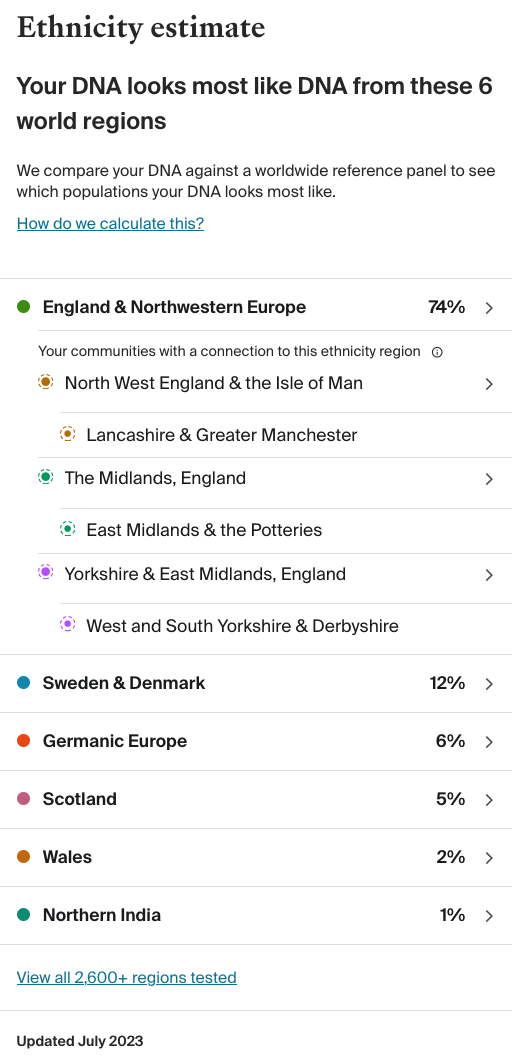
23andMe
Ancestry Composition
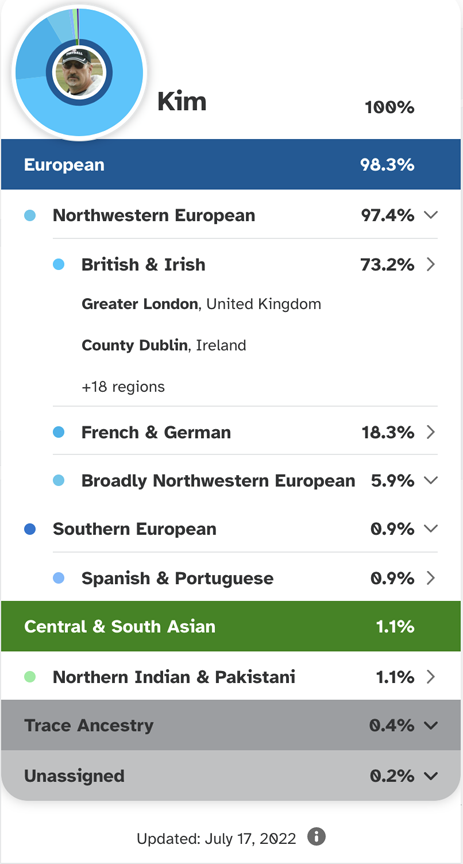
Ancestry Composition

CRI
Ancestry Recent Analysis
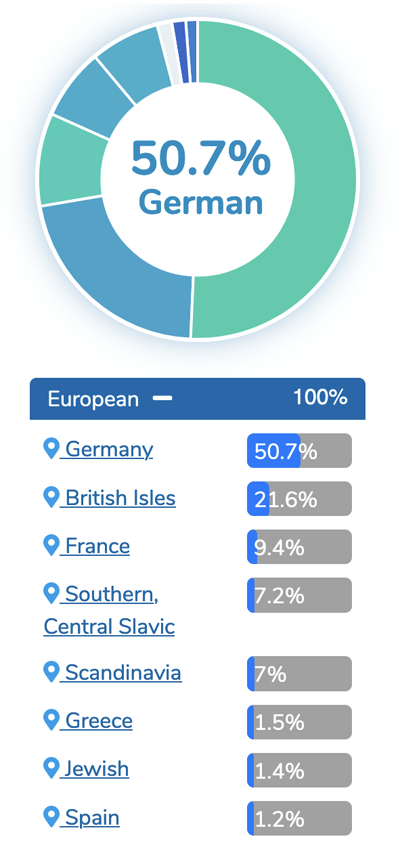
Ancestry Recent Analysis

2024 Result

Maternal Haplotype
23andMe
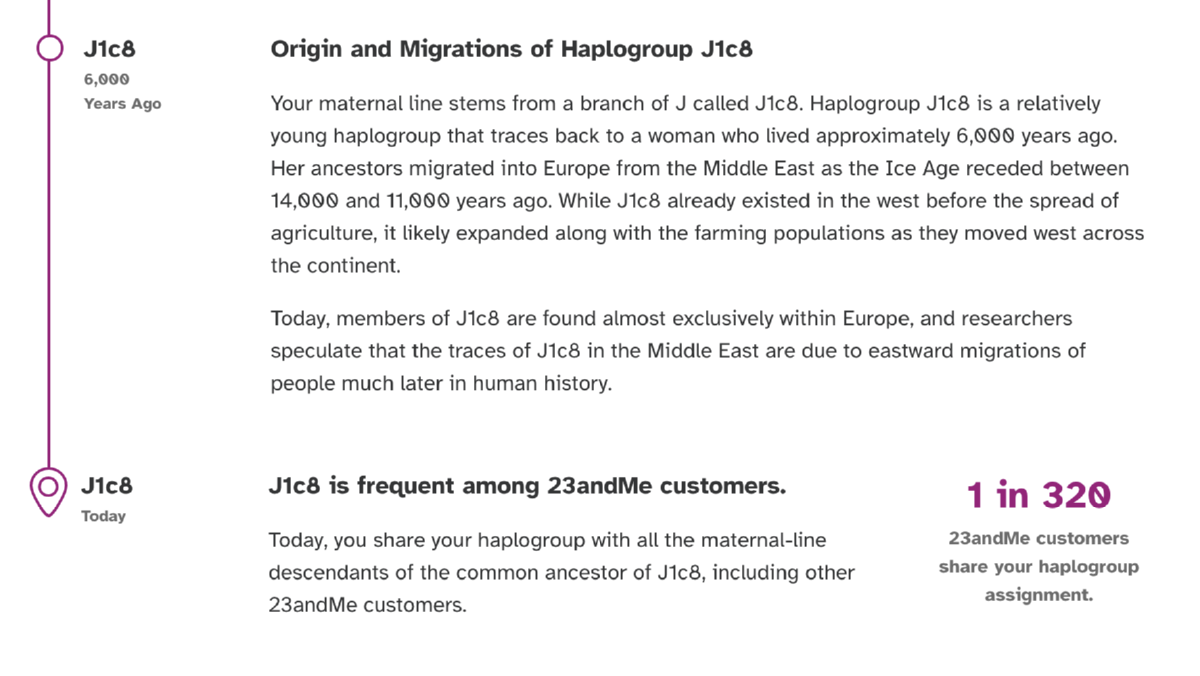
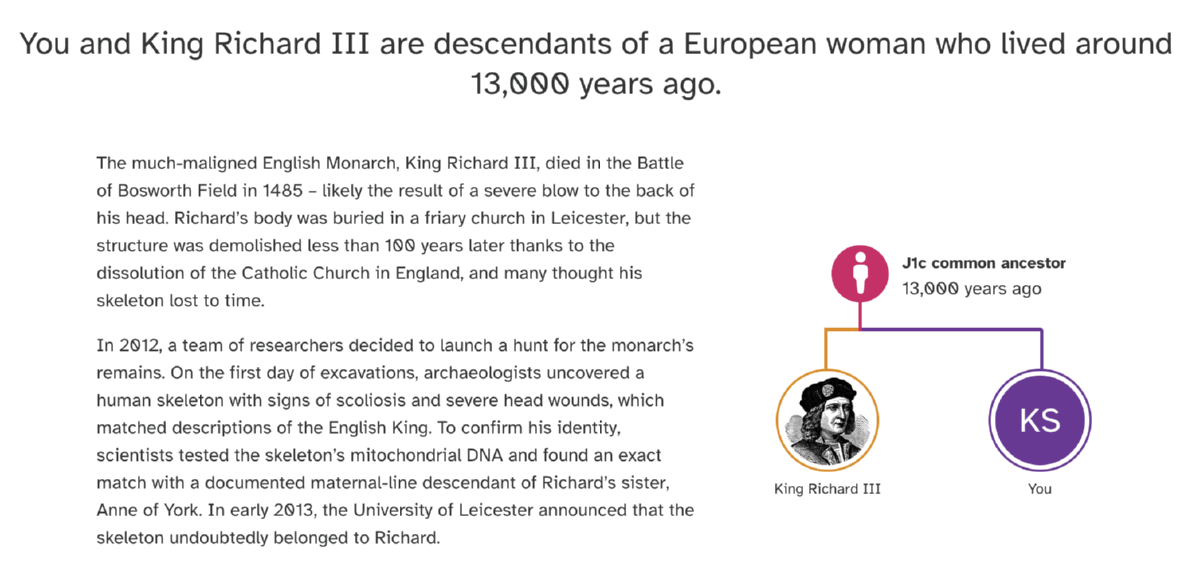
Maternal Haplotype
CRI
CRI
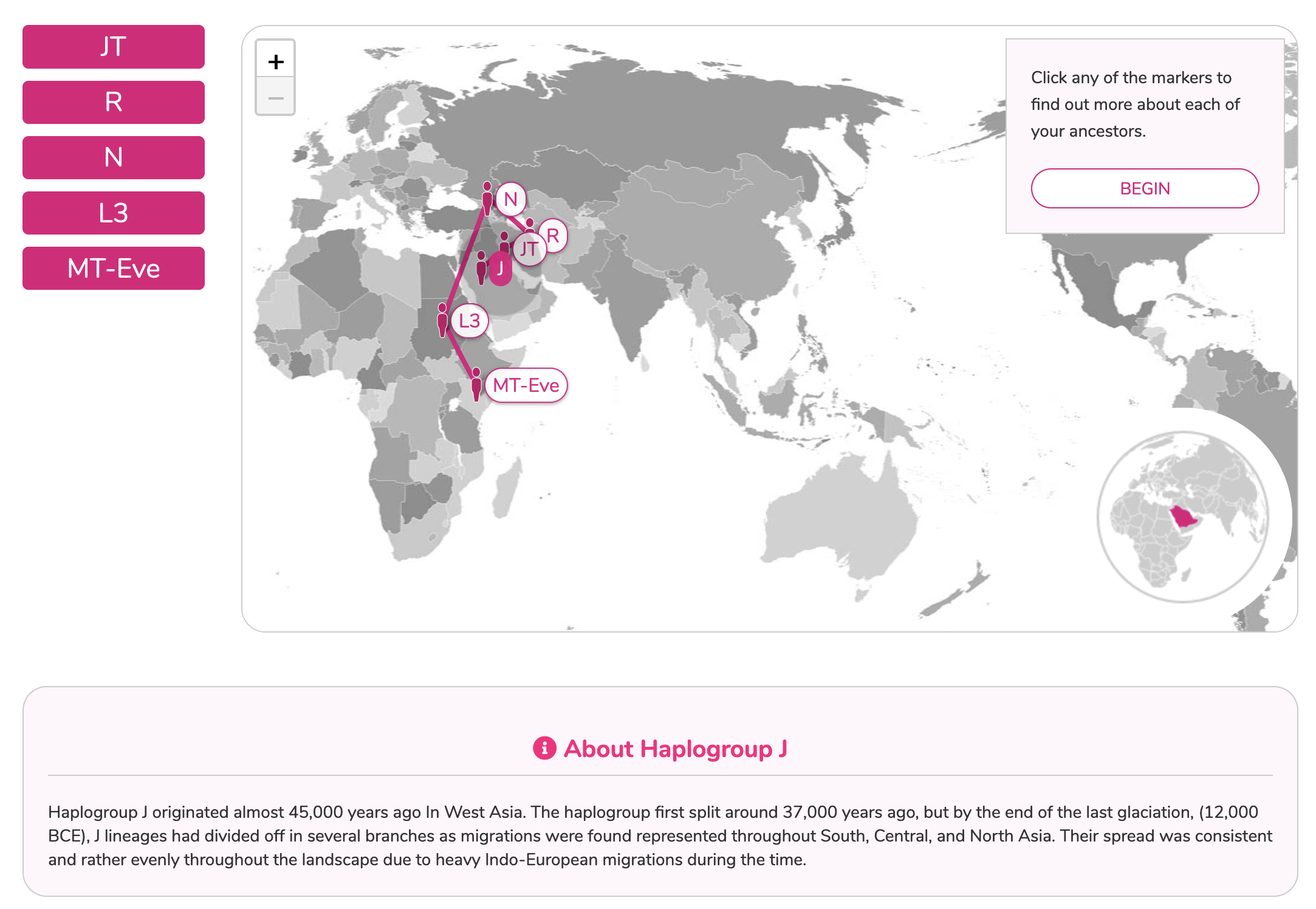
The maternal haplogroup results from 23andMe and CRI agree. CRI gives J while 23andMe gives a more specific J1c8.
Paternal Haplotype
23andMe
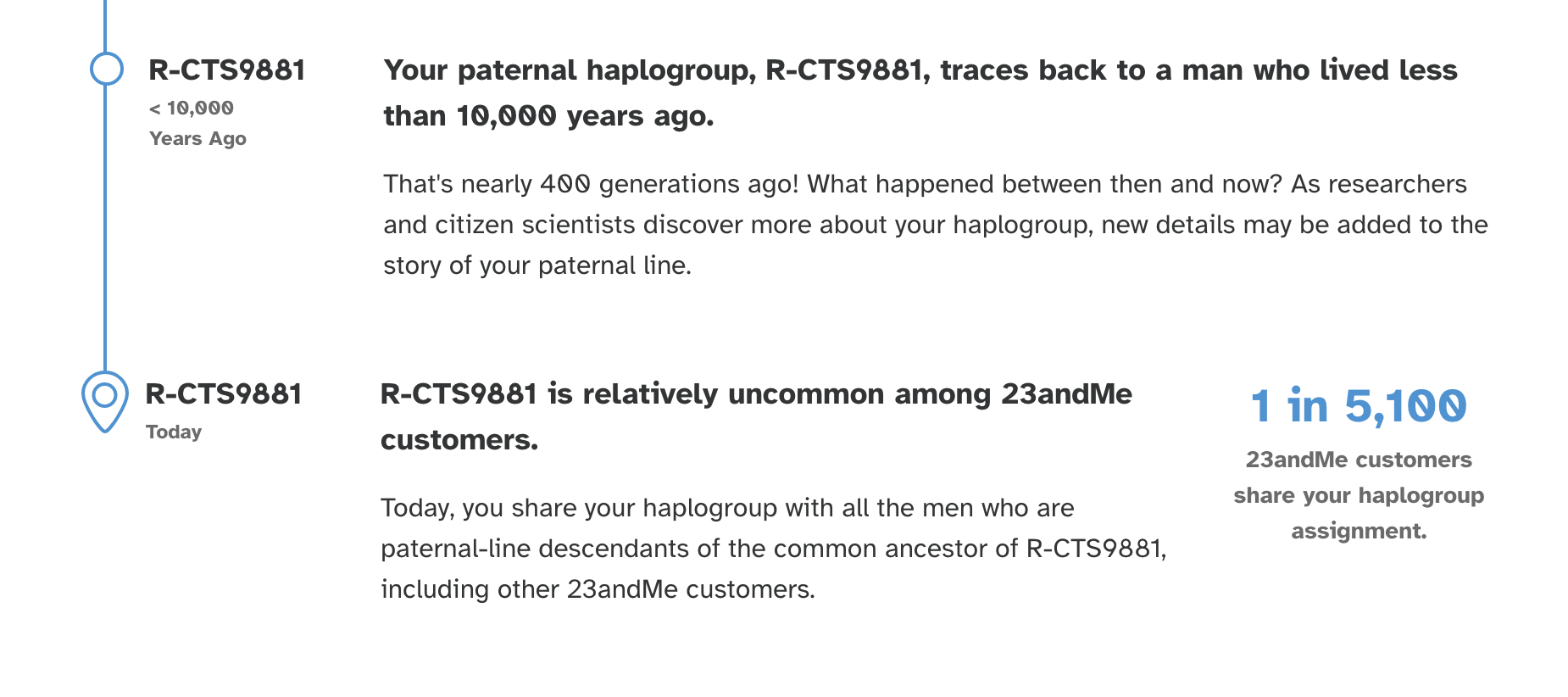
23andMe

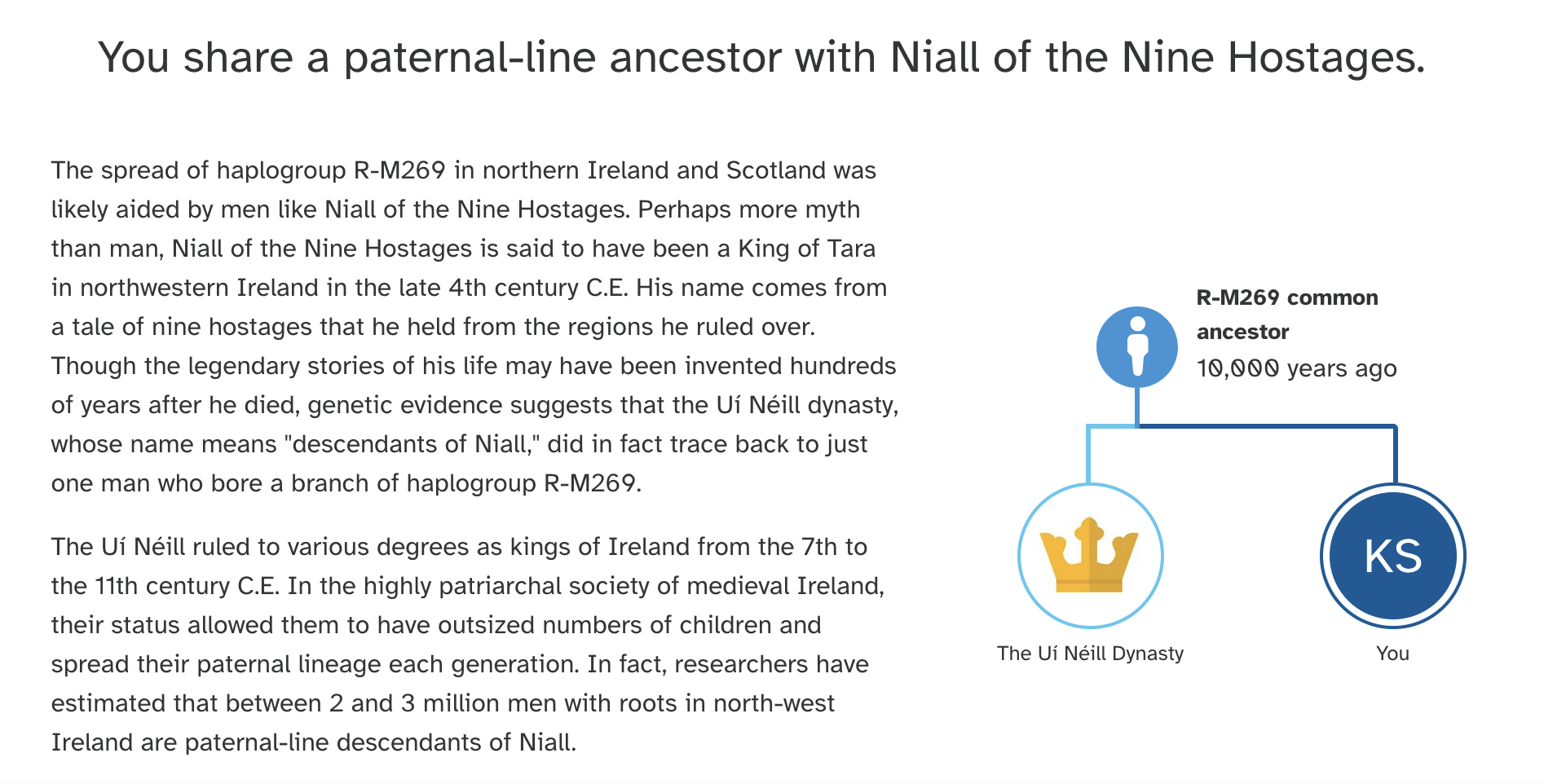
Paternal Haplotype
CRI
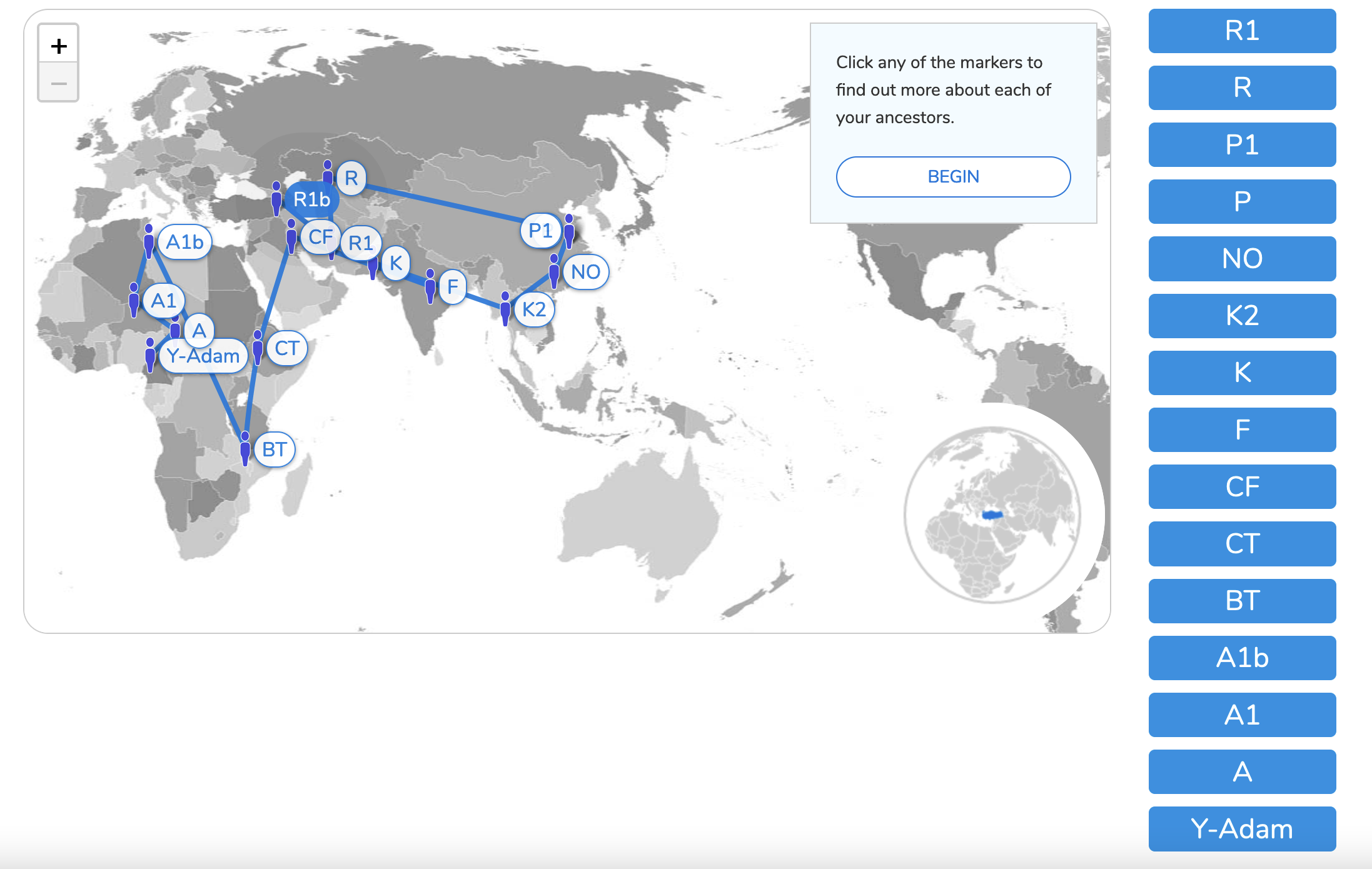
CRI


Note: From what I understand there are two methods of naming haplogroups. One is by types of mutations called single-nucleotide polymorphisms (SNP's) which would have meaning to those who study DNA but not to amateurs such as myself. The other is by phylogenetic tree ("family tree") which is more understandable to people like me. Thus haplogroup M207 (R) has mutations M173 ((R1) and M479 (R2). Further mutations of R1, are for example M420 (R1a) and M342 (R1b), and so on. Since different companies give results using one or the other method, comparison of results can certainly be confusing to many consumers.
CRI gives my haplogroup as R1b and 23andMe gives it as R-M269 with further mutations to the subclade R-CTS9881. In fact they agree, however the 23andMe result is much more specific. R-M269 is also known as R1b1a1b. I haven't been able to determine the phylogenetic name for R-CTS9881, if there is one.
Haplogroup R-M269 (R1b1a1b) is the most frequently occurring paternal lineage in Europe carried by an estimated 110 million males in Europe and, of course, by many of us of European descent. 23andMe suggests my subclade is quite rare and is often found (but not exclusively) in males whose with roots are in northwestern Ireland and is common with those in the Ui Neill dynasty. 23andMe indicates this subclade is found in only 1 in 5100 male customers. Amongst the 5000 closest DNA relatives indicated by 23andMe none of those males share my paternal Haplogroup, which may be disappointing, but based on the math, not surprising.
Neanderthal DNA
23andMe

23andMe


For clarification this does not mean I have 63% Neanderthal DNA! It is less than 2%. One would expect those of almost exclusive African to have little or no Neanderthal DNA and those of us of European, Asian or Native American to likely have some. For comparison purposes 5 people who have taken the23andMe test and I am able to place on my paternal grandmother's branch of the family tree have 24%, 35%, 63%, 72% and 74% more than other customers.
Historical DNA Matches
23andMe
23andMe
In late 2024 or early 2025 23andMe introduced a new feature described as historical matches. What they have done is compared the DNA from a number of archaeological finds with that of their customers. Below is a charts showing my results.

There a few points I think are important in understanding the results.
The Ancient and Historical groups they use to compare are not extensive. They are limited to what is available and which groups they chose to compare. I would think this list will expand over time, but still never be all encompassing.
The fact a person shares DNA with a particular individual such as Beethoven or a particular find in a group such as Ancient Rome does not mean they are directly descended from that individual. It does mean that both of them inherited DNA from a common ancestor.
The fact a person shares no DNA from a group such as Maya Sacrifice Victims from Chichen Itza may be also be helpful.
All of my results share 1 segment and state I am very distantly related to that individual.
For 14 of the 18 groups they use, my DNA matches with no individuals.
Updated January 20, 2025
Top of Page
Contents (Home Page)
*
Index
*
Surnames
*
Contact
Navigation * Charts * Dedication * Lest We Forget * Thanks * Would You Believe * DNA
Links * Proven Companions * Kings * Saints * Knights of the Garter * Crusaders
Navigation * Charts * Dedication * Lest We Forget * Thanks * Would You Believe * DNA
Links * Proven Companions * Kings * Saints * Knights of the Garter * Crusaders
All information is provided for the free use of those engaged in non-commercial genealogical research.
Any commercial use is prohibited.
Kim Simmonds' Family Genealogy
https://kimsimmonds.net/
Any commercial use is prohibited.
Kim Simmonds' Family Genealogy
https://kimsimmonds.net/